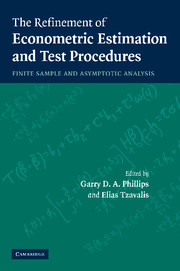Book contents
- Frontmatter
- Contents
- List of figures
- List of tables
- List of contributors
- Preface
- Acknowledgements
- Michael Magdalinos 1949–2002
- Introduction
- 1 Conditional Heteroskedasticity Models with Pearson Disturbances
- 2 The Instrumental Variables Method Revisited: On the Nature and Choice of Optimal Instruments
- 3 Nagar-Type Moment Approximations in Simultaneous Equation Models: Some Further Results
- 4 Local GEL Methods for Conditional Moment Restrictions
- 5 Limit Theory for Moderate Deviations From a Unit Root Under Weak Dependence
- 6 The Structure of Multiparameter Tests
- 7 Cornish-Fisher Size Corrected t and F Statistics for the Linear Regression Model with Heteroscedastic Errors
- 8 Non-Parametric Specification Testing of Non-Nested Econometric Models
- 9 Testing for Autocorrelation in Systems of Equations
- 10 Alternative Approaches to Estimation and Inference in Large Multifactor Panels: Small Sample Results with an Application to Modelling Asset Returns
- 11 Judging Contending Estimators by Simulation: Tournaments in Dynamic Panel Data Models
- 12 A Statistical Proof of the Transformation Theorem
- 13 On the Joint Density of the Sum and Sum of Squares of Non-Negative Random Variables
- 14 Conditional Response Analysis
- References
- Index
2 - The Instrumental Variables Method Revisited: On the Nature and Choice of Optimal Instruments
Published online by Cambridge University Press: 22 September 2009
- Frontmatter
- Contents
- List of figures
- List of tables
- List of contributors
- Preface
- Acknowledgements
- Michael Magdalinos 1949–2002
- Introduction
- 1 Conditional Heteroskedasticity Models with Pearson Disturbances
- 2 The Instrumental Variables Method Revisited: On the Nature and Choice of Optimal Instruments
- 3 Nagar-Type Moment Approximations in Simultaneous Equation Models: Some Further Results
- 4 Local GEL Methods for Conditional Moment Restrictions
- 5 Limit Theory for Moderate Deviations From a Unit Root Under Weak Dependence
- 6 The Structure of Multiparameter Tests
- 7 Cornish-Fisher Size Corrected t and F Statistics for the Linear Regression Model with Heteroscedastic Errors
- 8 Non-Parametric Specification Testing of Non-Nested Econometric Models
- 9 Testing for Autocorrelation in Systems of Equations
- 10 Alternative Approaches to Estimation and Inference in Large Multifactor Panels: Small Sample Results with an Application to Modelling Asset Returns
- 11 Judging Contending Estimators by Simulation: Tournaments in Dynamic Panel Data Models
- 12 A Statistical Proof of the Transformation Theorem
- 13 On the Joint Density of the Sum and Sum of Squares of Non-Negative Random Variables
- 14 Conditional Response Analysis
- References
- Index
Summary
Introduction
The method of Instrumental Variables (IV) was first formalized by Reiersol (1941) and Geary (1948, 1949) in the context of the errors-in-variables (confluence analysis) using time series data. The IV method was introduced as an alternative to least-squares in an attempt to deal with the inconsistency of the ordinary least-squares (OLS) estimator. Durbin (1954) systematized and extended the IV method to a general linear relationship where the explanatory variables are correlated with the error term. He also conjectured a direct relationship between the IV estimator and the limited information maximum likelihood (LIML) estimator in the context of the simultaneous equations model (SEM). This conjecture was formally confirmed by Sargan (1958) who extended the scope of the IV method by relating it to maximum likelihood methods, establishing the IV as a general estimation method in econometrics. Since then the IV method has been increasingly used both as a unifying concept in econometric estimation (see Hendry, 1976; Hausman, 1975; Bowden and Turkington, 1984; inter alia), as well as a computationally convenient method (see Brundy and Jorgenson, 1974; Hansen and Singleton, 1982). More recently, the IV method has been extended in a number of ways to unify estimation and testing procedures in a non-maximum likelihood framework (see White, 1982, 1984), misspecification testing (see Pagan, 1984), as well as unit-root testing (see Hall, 1989). Arguably, the most important extension has been the Generalized Method of Moments (GMM) proposed by Hansen (1982); see also Newey (1985).
- Type
- Chapter
- Information
- The Refinement of Econometric Estimation and Test ProceduresFinite Sample and Asymptotic Analysis, pp. 34 - 59Publisher: Cambridge University PressPrint publication year: 2007
- 4
- Cited by



